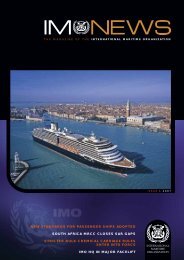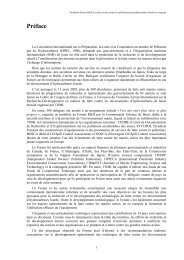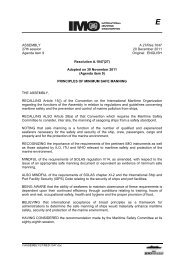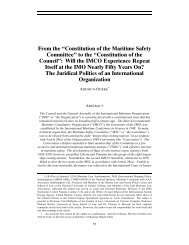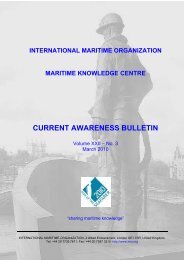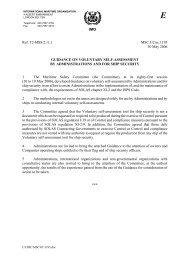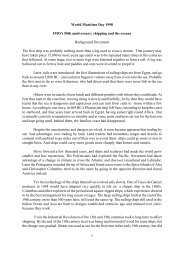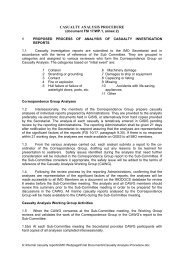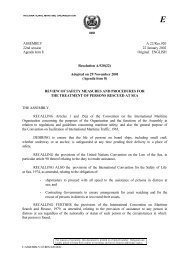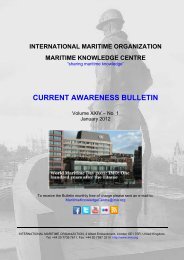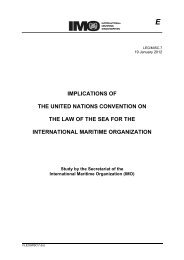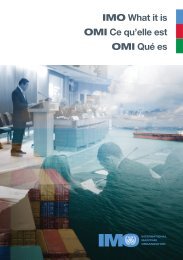Radioactive Waste Disposal at Sea: Public Ideas ... - IMO
Radioactive Waste Disposal at Sea: Public Ideas ... - IMO
Radioactive Waste Disposal at Sea: Public Ideas ... - IMO
Create successful ePaper yourself
Turn your PDF publications into a flip-book with our unique Google optimized e-Paper software.
188 Chapter 10<br />
In order to avoid transferring harm to other environmental sectors, the decision<br />
whether or not to dispose of <strong>at</strong> sea should, therefore, include a comparison<br />
with harm from using other disposal options.<br />
The London Convention says, in its Annex 3, th<strong>at</strong> the competent n<strong>at</strong>ional<br />
agency should compare the risks from ocean disposal with the risks from<br />
land-based disposal methods before issuing a dumping permit. But such<br />
compar<strong>at</strong>ive risk assessments have not been carried out system<strong>at</strong>ically. As<br />
was documented in chapters 8 and 9, the risks from land-based methods of<br />
disposal of low-level radioactive waste were not system<strong>at</strong>ically taken into<br />
account when it was decided to ban radwaste disposal. The ban was largely<br />
based on the perceived risks to humans and the marine environment from<br />
ocean disposal.<br />
Marine scientists agree th<strong>at</strong> the ocean in principle has an assimil<strong>at</strong>ive<br />
capacity, and a consensus definition—“the amount of m<strong>at</strong>erial th<strong>at</strong> could<br />
be contained within a body of seaw<strong>at</strong>er without producing an unacceptable<br />
biological impact” (Stebbing 1992, p. 288)—was reached in 1979. 22<br />
From this definition it follows th<strong>at</strong> pollution is an unacceptable change to<br />
the environment but th<strong>at</strong> change in itself does not constitute pollution.<br />
GESAMP and the Advisory Committee on Marine Pollution (ACMP) have<br />
endorsed the concept of assimil<strong>at</strong>ive capacity and thus distinguish between<br />
acceptable and unacceptable change to the marine environment. 23 In accordance<br />
with the Stockholm str<strong>at</strong>egy, they stress th<strong>at</strong> so-called holistic consider<strong>at</strong>ions<br />
should be made in all cases, radwaste disposal included (Bewers<br />
and Garrett 1987, p. 119). This, furthermore, would minimize the total<br />
harm inflicted on the environment.<br />
As I discussed in chapter 9, GESAMP was gre<strong>at</strong>ly concerned over the ban<br />
on radwaste disposal. GESAMP viewed the ban as an expression of a lack<br />
of confidence in regul<strong>at</strong>ory decision making concerned with issues characterized<br />
by scientific uncertain as well as a forerunner of the more recent<br />
trend within intern<strong>at</strong>ional environmental forums to adopt the precautionary<br />
principle. GESAMP also criticized the regul<strong>at</strong>ory approach taken by<br />
most intern<strong>at</strong>ional marine pollution arrangements because “the occurrence<br />
or risk of pollution becomes the major criterion for regul<strong>at</strong>ory action”<br />
(GESAMP 1991, p. 25). In its view, this is a conceptually flawed approach<br />
and it leads to haphazard regul<strong>at</strong>ion. GESAMP and ACMP instead stressed<br />
the need to distinguish between contamin<strong>at</strong>ion and pollution and the



